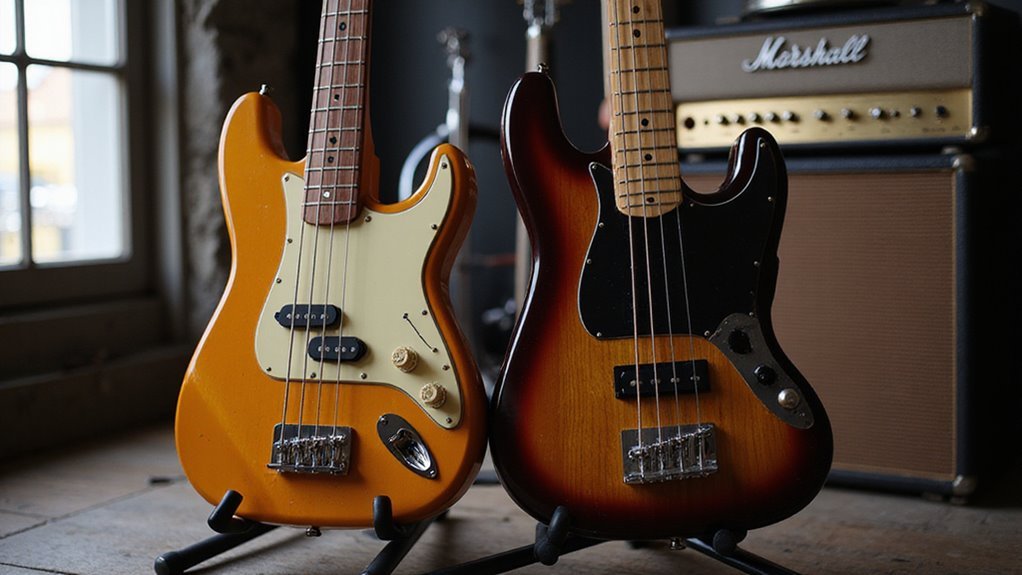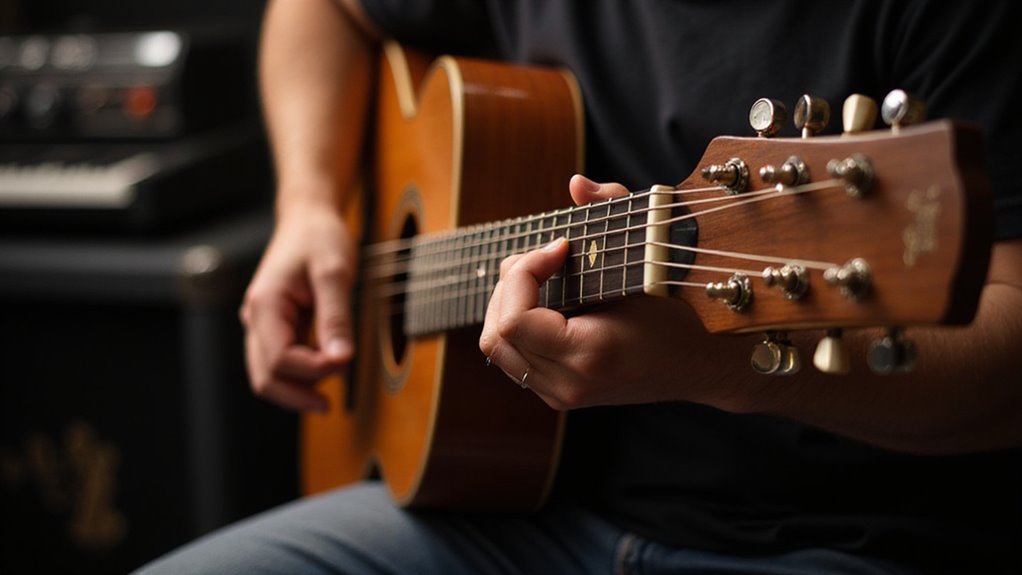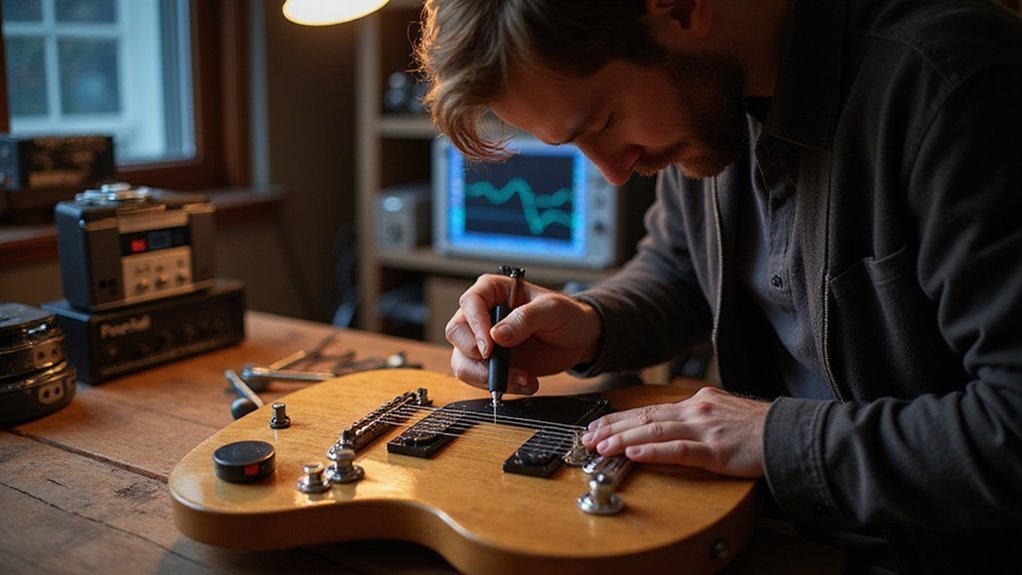Imagine the rich rumble of a bass guitar resonating through your chest, except it’s coming from your trusty six-string. You’ve probably found yourself jamming along to your favorite tracks, wishing you could nail those groovy bass lines without switching instruments. While guitars and basses serve different musical purposes, you can actually coax impressive low-end tones from your regular guitar with the right approach. Perhaps it’s time to explore this crossover territory—who knows what it might add to your musical toolkit?
Understanding the Fundamental Differences Between Guitars and Basses

While many people might assume guitars and bass guitars are merely variations of the same instrument, they actually serve fundamentally different purposes in music.
You’ll notice right away that bass guitars typically have just four strings compared to a guitar’s six, and they’re tuned an octave lower (E, A, D, G).
I think the most significant difference is in their musical role. Your guitar often handles melodies and lead lines, while bass creates the foundation that everything else sits on.
The neck is longer on bass guitars too, and those thick strings definitely feel different under your fingers. Perhaps this is why switching between them isn’t quite as simple as some might expect.
Essential Techniques for Playing Bass Lines on Six Strings

Since you don’t have a bass guitar readily available, mastering bass lines on your six-string guitar requires specific techniques to capture those deep, fundamental tones.
Make your guitar speak bass. No extra instrument needed—just technique and a touch of imagination.
I’ve found focusing on the lower strings (especially E and A) makes a huge difference in mimicking that bass sound we all love.
- Use your thumb or fingers instead of a pick for a warmer, rounder tone
- Focus on playing “in the pocket” – that locked-in rhythmic feel with the drums
- Try palm muting to control sustain and emphasize the percussive quality
- Experiment with octave positions to find the sweet spot that sits well in your mix
Optimizing Your Guitar Setup for Low-End Frequencies

The physical setup of your guitar plays an enormous role in how effectively you can produce those low-end frequencies. I’ve found that most standard guitars just aren’t configured for bass tones out of the box, but with some tweaking, you’ll get much closer to that deep, resonant sound we’re all after.
| Adjustment | Purpose | Difficulty |
|---|---|---|
| Heavier strings (0.52-0.60) | Increased bass response | Easy |
| Lower action | Better playability for bass lines | Medium |
| Neck relief adjustment | Prevents buzzing with heavy strings | Advanced |
| Pickup height lowering | Captures more string vibration | Easy |
| EQ pedal addition | Boosts low-end frequencies | Medium |
Perhaps the most impactful change is switching to heavier gauge strings. They’ll feel different at first, but your tone will thank you!
Amplifier Settings and Effects for Authentic Bass Tones
Creating authentic bass tones on your regular guitar requires more than just physical adjustments—amplifier settings and effects pedals play an essential role in shaping your sound.
I think the right combination can transform your guitar’s voice into something much closer to a bass, even with its inherent limitations.
When setting up your amp for bass lines, focus on:
- Boost low frequencies (around 80-100Hz) while cutting some mids
- Use compression to even out your dynamics and add sustain
- Consider an octave pedal to shift your notes down
- Try a touch of overdrive—just enough to add warmth without muddiness
Don’t worry if it takes time to dial in your perfect tone.
Experimentation is half the fun!
Developing Musical Proficiency Through Cross-Instrumental Practice
Why limit yourself to mastering just one instrument when practicing across instruments can exponentially boost your musical growth?
When you incorporate bass techniques into your guitar practice, you’re actually developing a more thorough musical vocabulary.
Mastering bass elements enriches your guitar vocabulary, opening doors to musical expression beyond standard technique.
I think the greatest benefit comes from training your ear to recognize how different parts interact. You’ll start to hear music differently—perhaps noticing the foundational elements you once overlooked.
Many guitarists find that their rhythm improves dramatically after practicing bass lines. It’s not just about playing notes; it’s about feeling the heartbeat of the music and connecting with your fellow musicians on a deeper level.
Frequently Asked Questions
Can Bassists Easily Transition to Playing Regular Guitars?
Yes, you’ll find the shift manageable. Your finger strength and fretboard knowledge will help, but you’ll need to adjust to thinner strings, more notes, and different playing techniques.
How Do Bass Techniques Translate to Songwriting on Guitar?
“Practice makes perfect” when adapting bass techniques to guitar songwriting. You’ll naturally incorporate rhythmic foundations, groove consciousness, and chord progression knowledge into your compositions, enriching your songs with deeper musical layers.
Will Playing Bass Lines Damage My Guitar’s Neck?
No, playing bass lines won’t damage your guitar’s neck. Your instrument is designed to handle standard tensions. Just make certain you’re not using excessively heavy strings that exceed manufacturer specifications.
Do Acoustic Guitars Work for Practicing Bass Lines?
Over 70% of bassists started on guitar! Yes, you can practice bass lines on acoustic guitars, especially on the lower strings. You’ll develop great fingerpicking technique while feeling part of both guitar and bass communities.
Can I Perform Bass Parts in a Band Without a Bassist?
You can perform bass parts in a band without a bassist, but you’ll face limitations in tone depth and frequency range. Consider using octave pedals or alternative tunings to improve your sound.
Conclusion
You’ve now got the tools to create bass lines so earth-shatteringly good on your regular guitar that bassists everywhere might start questioning their career choices! Remember, it’s not about perfectly replicating a bass guitar—it’s about creatively adapting your six-string skills. With practice, you’ll develop that essential rhythmic pocket feeling and, I think, perhaps even discover new musical possibilities that cross the traditional boundaries between instruments. Keep experimenting!